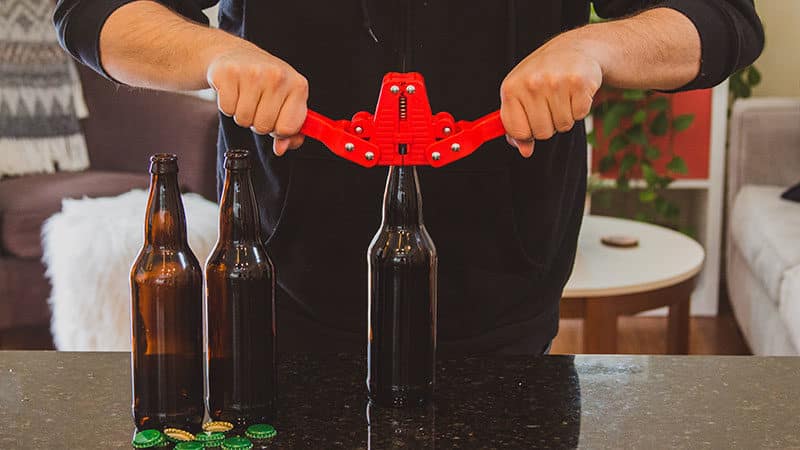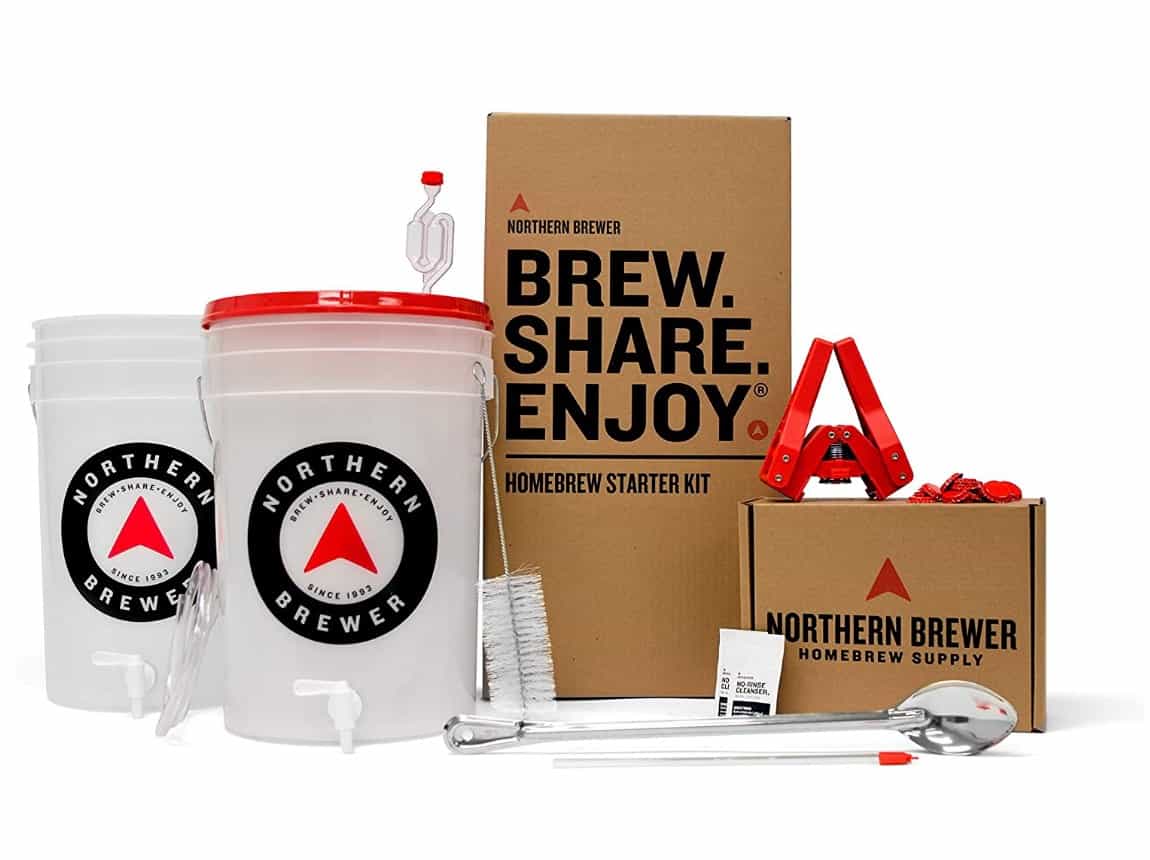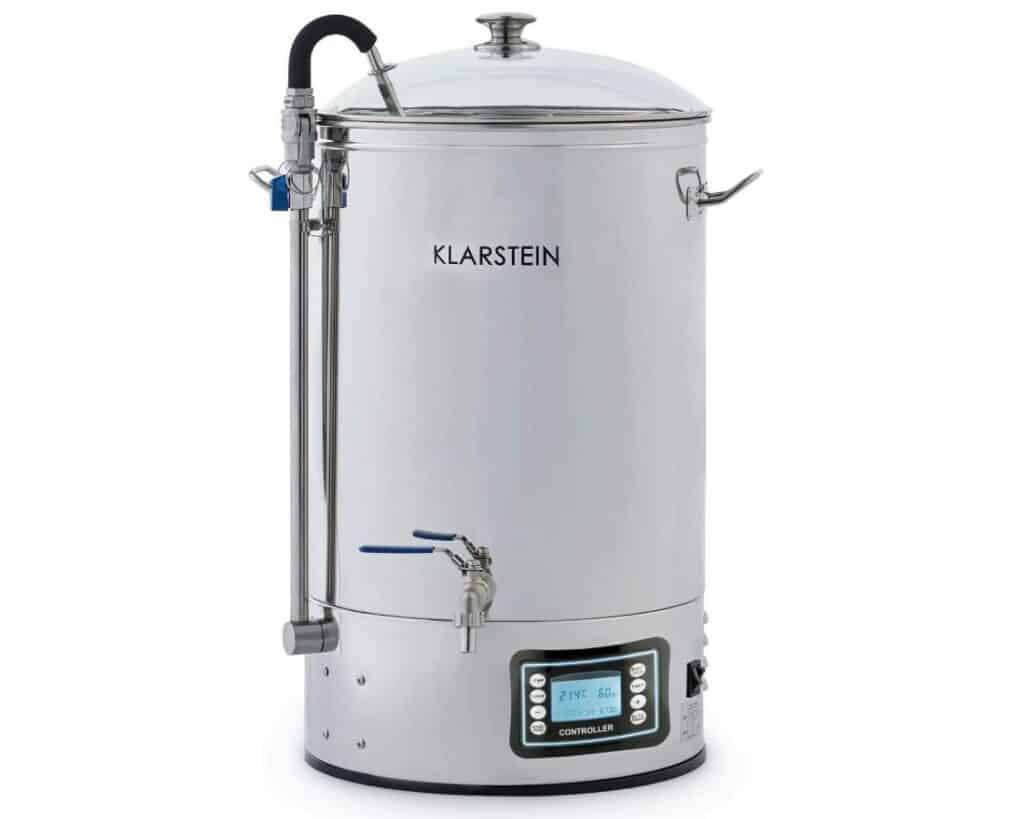- Rye Malt Guide – How to Use This Malt for Distinctive Homebrews - November 24, 2022
- Aromatic Malt Guide – Why I Use This Malt in My Homebrew Recipes - November 19, 2022
- Willamette Hops Guide – Why I’m a Fan of This Classic American Hop - November 9, 2022
The mass-produced beer we can get from supermarkets doesn’t taste as good as craft beer manufactured by local breweries. Getting the best home brewing equipment is the first step towards setting up a private brewery in your home and choosing a flavor of beer you want to make.
Whether you’re just thinking about making your first batch of beer or you’re looking for a way to produce several gallons of beer every week, homebrewing kits can help you get all the equipment you need to accomplish your goal.
So, in this guide, we’ll walk you through the best homebrewing equipment you’re going to need to start brewing beer, and we’ll help you choose a homebrewing kit that best fits your needs.
Getting Familiar with the Homebrewing Process
Figuring out how to approach homebrewing is one of the first obstacles you’ll have to overcome before you can produce your first batch of beer.
It’s worth pointing out that the term homebrewing doesn’t refer only to the process of making beer since it can also denote the production of mead or ciders for personal use. However, having the best home brewing equipment won’t be of much use if you don’t know what to do with it.
Besides consulting with the people at the local brewery and soaking up all the knowledge they’re willing to share, you should also read books like Charlie Papazian’s The Complete Joy Of Homebrewing or Randy Mosher’s Mastering Homebrew.
This way, you’ll become more familiar with different types of beer and find out more about different recipes and ingredients. Reading about the homebrewing process will also help you decide which style of beer you want to make and learn the details of producing lager or stout styles.
Types of homebrewing kits

Once you get more familiar with all the steps of making craft beer, you should start searching for the equipment you’ll use to produce your first batch. This process might seem simple, when in fact, it is anything but simply because there are so many homebrewing kits to choose from.
The equipment included in the kit varies from model to model, and you may have to purchase additional equipment if you opt for an entry-level starter kit. Based on the amount of equipment they include, homebrewing kits can be divided into basic and complete kits. Here’s what they have to offer.
Basic
Nearly all home brewing kits have the following components:
- A thermometer
- Triple scale hydrometer
- 3-piece airlock
- Auto siphon
- Stir spoon
Although a fermenting bucket is an essential piece of homebrewing equipment, it isn’t always included in the kit. What’s more, some homebrewing kits come with fermenting buckets that have a 1-gallon or 2-gallon capacity.
The volume of the fermenting bucket determines how much beer you can produce in one batch, so it is better to get a 5-gallon or a 7.5-gallon kettle to avoid the possibility of wort boiling over.
In addition, you’re going to need a sturdy bucket that can withstand a 60-minute boil regardless of the type of brew you’re trying to make.
Complete
Unlike the basic kits, complete kits include all components you need to complete the brewing process. These kits feature a brew kettle, as well as all other essential gear that enables you to monitor the speed, cool the wort, or transfer the beer from one container to another.
Complete homebrewing kits often include recipes for a particular style of beer, while some kits are designed for a specific type of craft beer. These kits can also include bottles and bottle cleaning equipment that enables you to use the same bottles every time you make a new batch of beer.
The vast majority of complete homebrewing kits are reusable, so you just have to sanitize them after brewing a batch of beer. The durability of a homebrewing kit depends on the model or where it is stored, which makes it difficult to determine how long a particular kit is going to last.
Preparing the ingredients
The ingredients you’re going to need to make a batch of beer are not the same for all styles of beer. That’s why you should go through the recipe you’d like to try and check which ingredients you’re going to need.
Yeast is one of the ingredients all craft beer recipes have in common, but a vial of liquid yeast doesn’t contain enough cells to produce a high-gravity ale. Experienced craft beer brewers prepare yeast starters that enable them to make lagers or high-gravity ales without additional expense.
The process involves multiplying the number of cells in a vial of liquid yeast by supplying it with nutrition. This is usually done by preparing a small amount of wort that allows the cells to reproduce. It takes around 24 hours to prepare a yeast starter for a craft lager or any other style of high gravity beer.
It’s worth adding that the type of yeast and the fermentation method depends on the beer style you want to make.
Estimating the size of the brew batch size

The fermenting buckets or brew kettles limit the volume of beer you can produce in a single batch. Most home brewing kits come with kettles that can hold up to 5 gallons of the wort, but you should bear in mind that this is their maximum capacity.
The wort and water contain high amounts of dissolved gasses that cause them to boil over, while the wort that is made of malt is full of proteins that turn into the foam during the boiling process that lasts around one hour.
For that reason, you should never utilize the maximum capacity of a fermenting bucket because you won’t be able to contain the wort once it starts boiling. So, if you have a 5-gallon bucket, you should prepare 4.5-gallon for the wort to eliminate the chances of wort boiling over.
Besides, you will lose around a gallon of water during the boiling process, and you’ll end up with 3.5-gallons of wort after the process is complete.
The importance of cooling the wort
Reducing the temperature of the wort after boiling is the crucial step of the brewing process, and you can use two different methods to drop the wort’s temperature.
Creating an ice bath is the cooling method utilized by novice brewers, and it can take between forty minutes and one hour before the wort’s temperature reaches an acceptable range.
Boiling puts the wort’s temperature in the range that is ideal for the development of toxic bacteria, which is why it is important to drop the temperature below 80F as soon as possible. A wort chiller will enable you to reduce the temperature to 80F in twenty minutes to half an hour.
Although expensive, wort chillers are a great investment that will make the process of making craft beer much smoother, and they’ll provide you with more control over the bitterness level generated by the hops.
The most important factors to consider while choosing the homebrewing equipment
How successful your attempt to make craft beer is going to depend on the gear you get, as even a seemingly insignificant piece of equipment can make a huge difference.
Rather than buying each component separately, you can get a homebrewing kit that includes all the equipment you need to produce your first batch of beer.
Also, you should get a system that accommodates your needs, so there’s no need to get a setup that enables you to produce tens of gallons of craft beer if you’re just setting up your home-based brewery.
Let’s take a look at some of the most important factors that can help you find the homebrewing equipment that matches your expectations.
Check the kettle’s capacity
The first thing you’ll need to do when you start considering different home brewing kits is to check if the kit includes a fermenting bucket.
In case you’d like to get a kit that doesn’t have a kettle, you’ll either have to use a regular pot or get a fermenting bucket explicitly designed for the purpose of producing craft beer. What’s more, homebrewing kits come with kettles that can hold between 1 and 10 gallons of wort.
Although it is hard to know exactly how much beer you want to make in advance, doing so can help you choose the right size of the fermenting bucket.
Find out which styles of beer you can brew with a specific kit

You need to decide which style of beer you want to make before purchasing a homebrewing kit because not all models contain the equipment you need to produce all styles of beer. So, a kit can be aimed at brewers who want to make stout, Norfolk bitter, red malt, India Pale Ale (IPA), or even cider.
Most of these kits include ingredients you need to produce a specific style of beer, but they might not feature all the equipment you need to complete the brewing process.
Getting a kit that comes with the ingredients for the style of beer you want to make will save you the trouble of searching for a particular type of yeast or hops. On the other hand, it may limit your options to make other styles of craft beers if it lacks some pieces of equipment.
Search for a kit that has a wort chiller
Worth chillers are by no means an essential part of a homebrewing system. Nonetheless, having a wort chiller can be useful because it will provide an easy way of controlling the wort’s temperature.
Consequently, you won’t have to worry about dangerous bacteria or bitterness of the batch because you’ll be able to drop the temperature before extracting additional bitterness from the hops or allowing bacteria to develop.
Choosing a homebrewing kit that already has a wort chiller will reduce the costs of creating a homebrewing system since you won’t have to purchase this component separately. Most worth chillers cost between $100 and $300, although some models can be purchased for $50 or less.
Get a homebrewing kit with an airlock
Contamination is one of the most common reasons why craft beer batches fail, and you need to do everything in your power to prevent contamination during the brewing process.
Besides sanitizing all equipment, airlocks are the most effective way to protect fermenting beer from contamination by ambient bacteria. In addition, an airlock reduces oxidation risks and prevents carbon dioxide buildup that can lead to an explosion.
Optionally, you can use a blow-off tube instead of an airlock to reduce the pressure within the fermentor and transfer the foam into another container. Although there are numerous types of airlocks, most seasoned brewers utilize 3-piece airlocks because they are easy to use and clean.
Consider getting a bottling kit

After the brewing process is completed you will need to store the beer you made for several weeks until it is properly carbonated. Hence, you will need beer bottles and caps that can store the entire batch you produced.
You should consider getting a bottling kit if you’re planning on making beer frequently because it will spare you the trouble of searching for containers you can use to bottle your beer.
It will also make it easier to sanitize and keep the bottles clean since most bottling kits come with brushes and sanitation products.
Read our full guide on how to find the best Empty Flip-Top Bottles for Brewing or the best Counter Pressure Bottle Fillers.
Pick a homebrewing kit that fits your budget
The exact cost of a homebrewing project doesn’t only depend on the equipment because the ingredients, brewing method, or sheer volume of beer you’d like to brew all affect the project’s cost.
Even the cooling method you choose can increase the total cost of your project since filling a bathtub with ice bags can take an additional $20 to $40 of your budget.
An entry-level homebrewing kit costs around a hundred dollars, but these kits often don’t include fermentation buckets, thermometers, and similar equipment.
A complete kit that includes all the equipment you need to brew craft beer usually costs between $200 and $500, depending on the model, and you should choose the option that accommodates your needs and fits your budget.
The advantages of homebrewing equipment
Brewers can make different styles of beers
Getting homebrewing equipment enables you to choose the fermentation method, try out different craft beer recipes, and brew ale, lager, and other beer styles. In most cases, you’ll be able to use the same brewing system to produce multiple styles of beer.
Complete control over the brewing process
The homebrewing equipment allows you to handle dangerous gases, reduce the wort’s temperature or transfer beer from one container to another effortlessly. All home brewing equipment is easy to use, so you won’t need a lot of time to figure out how to set up an airlock or rack beer with an auto-siphon.
Cut costs on beer
You can get more than 50 12oz beer bottles from a single 5-gallon batch, so even if you’re drinking beer every day, it will take a while before you have to make another batch.
Ultimately, making craft beer will reduce the amount of money you’re spending on beer because you won’t have to get a six-pack every time you’re meeting your friends.
Frequent craft beer production
Creating a homebrewing system enables you to produce craft beer you can share with your friends. As you become more experienced with different brewing processes you can start to supply bars with craft beer you make.
Low storage requirements
The entry-level gear you’ll be using to make beer isn’t going to occupy a lot of space in your apartment, as the only bulky piece of equipment is a fermenting bucket. Setting up an advanced homebrewing system capable of producing tens of gallons of beer will require ample storage space.
The disadvantages of homebrewing equipment
Some pieces of homebrewing equipment break down easily
Although most home brewing kits are reusable, some of their components can start to wear out after several batches. Consequently, you have to upgrade your homebrewing setup constantly, as it is impossible to know when you’re going to need a new thermostat or an airlock.
High maintenance requirements
The bacteria that gets in contact with the wort can affect the quality of a beer batch. That’s why all equipment you use to make craft beer has to be sanitized before and after the brewing process.
However, this process can be time-consuming and even challenging if you’re trying to clean beer bottles you used before.
Top 4 best home brewing equipment kits
The market is saturated with homebrewing kits designed for all levels of brewers, so you can opt for a kit that lets you make a gallon of beer or a system that lets you brew 10 gallons of beer in a single batch.
In addition, some kits include the ingredients you’re going to need to make a specific style of craft beer and save you the trouble of searching for the right yeast and hops. We’ve shortlisted some of the best home brewing equipment kits, so here’s what they have to offer.
Brooklyn Brew Shop Kit

Newcomers to the world of craft beer and homebrewing should consider getting the Brooklyn Brew Shop Kit because it comes with the ingredients you need to make IPA beer. Optionally, you can opt for models that contain ingredients for Chocolate Maple Porter and Bruxelles Blond beers.
The Brooklyn Brew Shop Kit comes with a 1-gallon fermenter, a thermometer, an airlock, and a racking cane. However, the kit doesn’t include the wort chiller so, to avoid placing the fermenter into a cold tub, you will have to get additional equipment.
The final product should contain 6.8% of alcohol, and you’ll produce enough beer to fill 8 to 10 bottles.
BrewDemon Craft Beer Brewing Kit

Besides the homebrewing equipment, you’ll also get the recipe for American Prophecy Ale if you opt for the BrewDemon Craft Beer Brewing Kit.
The kit ships with the 2-gallon conical fermenter that provides UV protection to the beer and a CO2 vent that reduces the chances of carbon dioxide buildup to the minimum. You’ll also get a temperature gauge, a mixing spoon, a spigot, an airlock, and a gasket if you choose this homebrewing kit.
The BrewDemon Craft Beer Brewing Kit includes plastic bottles and caps, as well as a bottle filler that simplifies the bottling process.
Here’s a complete guide on finding the best conical fermenters for your needs.
Northern Brewer Homebrewing Starter Kit

Although aimed at novice brewers, the Northern Brewer Homebrewing Starter Kit includes everything you need to produce high-quality craft beer. The 6.5-gallon fermenter bucket is equipped with a spigot that makes it easier to move the wort to the bottling bucket that is also included in the kit.
Unlike many other kits, the Northern Brewer Homebrewing Starter Kit features a bottle cleaning brush and the Oxygen Wash sanitizer that enables you to keep your equipment clean throughout all stages of the brewing process.
In addition, you’ll get the Block Party Amber Ale recipe kit if you choose this Northern Brewer model.
Klarstein Mundschenk Homebrewing System

Brewers interested in the equipment that can enable them to make more than 50 pints of craft beer should take a closer look at the Klarstein Mundshcenk Homebrewing system.
This mesh kettle can store up to 7.9 gallons of beer, and it features an LCD touch display that lets you set the boiling time or adjust the temperature. In addition, you can operate the system manually if you want to have control over all aspects of the brewing process.
The mash kettle is made of stainless steel, and it is easy to clean and sanitize after use.
Frequently asked questions about home brewing equipment
Question: Is the homebrewing process dangerous?
Answer: If done correctly, the homebrewing process isn’t dangerous, but failing to use an airlock or a blow-off tube can cause a CO2 buildup that leads to an explosion.
Question: How long can I use homebrewing equipment?
Answer: Each piece of homebrewing equipment that shows signs of deterioration should be replaced immediately. You should change all components of the homebrewing kit at least once per year, if not more often.
Question: When will my craft beer be ready for consumption?
Answer: You need to wait for two weeks after completing the bottling process before you can taste the beer batch you made. Opening a bottle before the two-week period expires may interrupt the carbonization process and prevent full fermentation of the beer.
Question: Do I need a fermenting bucket?
Answer: You can use a pot or any other metal and plastic container with enough volume to store the amount of wort you prepared instead of the fermenting buckets included in standard homebrewing kits.
However, racking the wort stored in a fermenting bucket is easier than transferring it from one pot to another.
Final thoughts: How to choose the best home brewing equipment?
Brewing craft beer in your home has become a popular pastime because the homebrewing kits have made the homebrewing equipment more accessible than ever before. Besides, some kits even include the recipes and ingredients you need to make a particular style of craft beer.
We recommend choosing the Brooklyn Brew Shop Kit or the BrewDemon Craft Beer Brewing Kit if you never used homebrewing equipment before to make a batch of beer because both of these kits are easy to use, and they help you avoid being stuck with a large quantity of beer.
Brewers in need of excellent home brewing equipment that enables them to make more than 5 gallons of beer in a single batch should consider getting the Klarstein Mundshcenk Homebrewing system. Did you find this guide to the best home brewing equipment useful? Leave a comment and let us know.
Continue reading related guides and reviews to must have homebrewing equipment:
